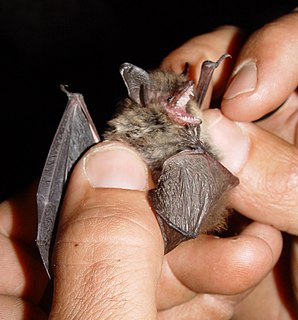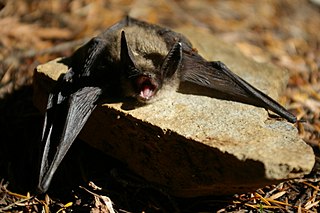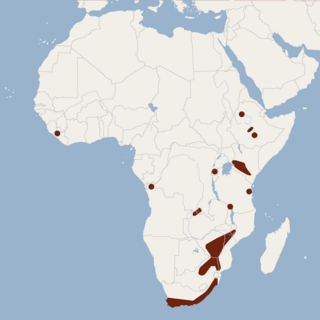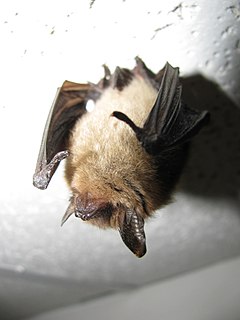Western long-eared bat may refer to the following bat species:
- Myotis evotis , also known as long-eared myotis, found in North America
- Nyctophilus major , found in southwest Australia
Western long-eared bat may refer to the following bat species:

The mouse-eared bats are a diverse and widespread genus (Myotis) of bats within the family Vespertilionidae.

The Alpine long-eared bat or mountain long-eared bat is a species of long-eared bat. It was originally described from Switzerland and Austria as a species intermediate between the brown long-eared bat and the grey long-eared bat in 1965. It was later described in 2002, from France and Austria, respectively. Despite its name, this species is not restricted to the Alps, being found in Croatia, Bosnia and Herzegovina and elsewhere. It differs from other European long-eared bats, such as the brown long-eared bat, by its white underparts.

The greater mouse-eared bat is a European species of bat in the family Vespertilionidae.
The Ethiopian big-eared bat or Ethiopian long-eared bat is a recently described species of long-eared bat in the family Vespertilionidae.

Rafinesque's big-eared bat, sometimes known as the southeastern big-eared bat, is a species of vesper bat native to the southeastern United States.

The southwestern myotis is a species of vesper bat. It is found in Guatemala, Mexico, and in Arizona and New Mexico in the United States.

The long-eared myotis is a species of vesper bat in the suborder Microchiroptera. It can be found in western Canada, the western United States, and Baja California in Mexico.

Keen's myotis is a species of vesper bat. It is found in British Columbia in Canada and in Washington and Alaska in the United States. It is named after the Rev. John Henry Keen, who collected the specimen that formed the basis for the first scientific description of the species. Classification for Keen's myotis formerly included the Northern long-eared Myotis, resulting in older studies confusing the species for one another.
Scott's mouse-eared bat is a species of vesper bat. It is found only in Ethiopia, in subtropical or tropical moist montane forests and shrubland. It is threatened by habitat loss.

The Cape hairy bat, also known as little brown bat, Temminck's mouse-eared bat, Cape myotis, tricoloured mouse-eared bat, Cape hairy myotis, Temminck's hairy bat and three-coloured bat is a species of vesper bat that is found in Sub-Saharan Africa.

Welwitsch's bat also known as Welwitsch's mouse-eared bat or Welwitsch's myotis is a species of vesper bat native to Africa.
Myotinae is a subfamily of vesper bats. Submyotodon is the second extant genus included in the subfamily Myotinae. Before the description of Submyotodon and analysis of its phylogenetics, the only member of Myotinae was the genus Myotis.

The eastern water bat or Sakhalin bat is a species of mouse-eared bat. It was for a long time considered to be a subspecies of Myotis daubentonii.

The northern myotis, also known as the northern long-eared bat, is a species of bat native to North America. There are no recognised subspecies. The northern long-eared bat is about 3–3.7 inches in length, with a wingspan of 9–10 inches. It is distinguishable by its long ears when comparing it to other bats in its genus. This species is commonly found in the northern United States and Southern Canada east of British Columbia. The geographic range includes 37 states.

The lesser mouse-eared bat is a species of insectivorous bat in the family Vespertilionidae.
There are eighteen indigenous species of bats in Canada, which are found in many parts of the country. They are insectivores, and are prey to falcons, hawks, owls, snakes, cats, and raccoons.
Northern long-eared bat is a common name for several flying mammals, species of Chiroptera